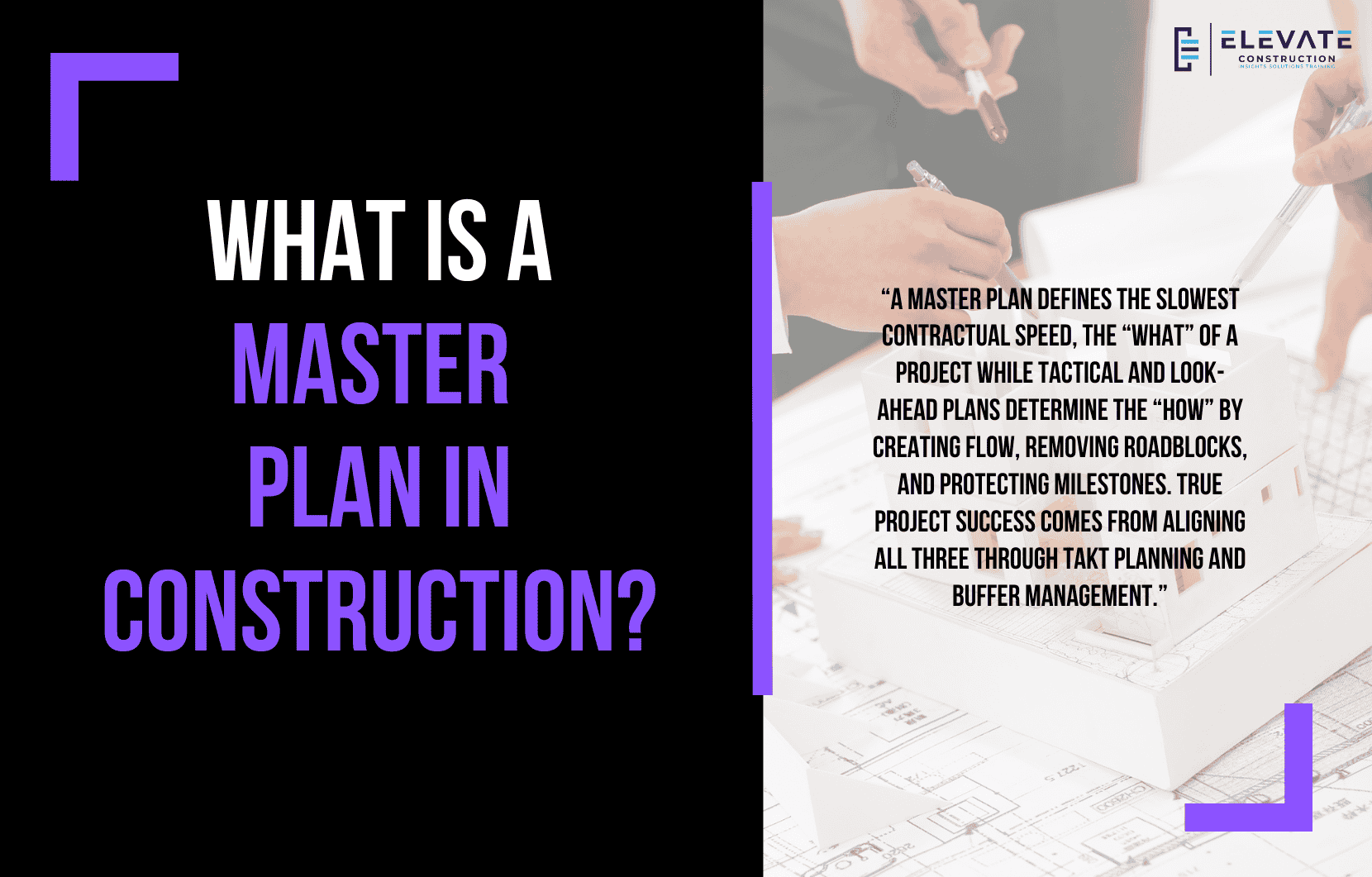What is a Master Plan in Construction?
I am so stoked about this blog, because I love talking about planning. This blog gives me an opportunity to dive into strategic planning, tactical production planning, and to answer some of the common questions we’ve been getting. I love the interaction, when readers ask questions, it allows me to clarify and share more value.
So today, I’ll tackle six key questions about the master plan in construction.
What is a Master Plan in Construction and Who Creates It?
There are many ways this can be done. Sometimes owners hire multiple prime contractors. Sometimes there’s a construction manager overseeing the general contractor. Other times, it all goes through the GC.
Whoever is running the project and carrying the contractual risk should create the master plan. Of course, it must be developed in collaboration with the CM and trade partners.
My favorite approach? A Macro-level Takt plan.
The Purpose of the Master Plan
Your macro-level takt plan is the “what”– what must be accomplished. Short interval planning, on the other hand, is the “how.”
The master plan is essentially:
- The slowest reasonable contractual speed.
- Plus your risk analysis.
- Plus your reference class forecast.
It sets the base minimum contractual requirement for milestones, durations, and performance, factoring in project risk.
Tactical Production Planning
The tactical production plan works within your phases. It ties your start dates, phase milestones, buffers, interdependencies, and end dates together. Phase by phase, everything is locked into your master plan.
When you do tactical production planning, it becomes phase-specific.
Accelerating Milestones
One of the great things about tactical planning is the ability to accelerate milestones. You can achieve this by:
- Zoning properly with the takt production system.
- Identifying trade bottlenecks.
- Finding zone bottlenecks and other constraints.
By doing this, you can speed up a phase and gain buffers without hurting trade partners.
Master Plan vs Tactical Plan
Here’s the distinction:
- Master Plan = the “what” (your slowest contractual speed).
- Tactical Plan = the “how” (your fastest reasonable speed, achieved through takt zones and buffers).
The key is the takt production system.
Master Plan vs Look-Ahead Plan
- Master Plan: Slowest contractual speed.
- Tactical Plan: Fastest reasonable speed.
- Look-Ahead Plan: A 3–6-week filter of the tactical plan to make work ready and remove roadblocks.
Can You Follow a Master Plan and Still Lose Production?
Yes. If you try to build directly from a macro-level takt plan, you will lose production. Why? Because the master plan is only the contractual promise – the strategy.
Real production requires smaller zones, pull planning, and establishing your target speed. That’s what drives weekly work plans and ensures efficiency.
Aligning Master Plans and Pull Plans
Here’s the key: master plans set start and end milestones. Pull planning phases with smaller zone sizes lets you optimize sequences and gain buffers.
As long as your phase finishes before the milestone in the master plan, you’re good. This is called vertical alignment.
What If the Master Plan Doesn’t Match the Field?
If your plans don’t match reality, get them aligned immediately. Update your pull plans, look-aheads, weekly work plans, and day plans. Do a complete audit, show reality, and reset flow toward the finish path.
Flow-Based Planning vs CPM
If a PM only cares about milestones, here’s the explanation:
- CPM leaves you vulnerable. One delay and you’re “forked.”
- Flow-based planning with takt zones builds buffers, absorbs impacts, and protects milestones without sacrificing trade partners.
This is why takt, zoning, and buffers matter, they ensure reliability and protect your team’s time and families.
The Bottom Line
- Master Plan: The slowest contractual speed (the “what”).
- Production Plan: The fastest reasonable speed (the “how”).
- Look-Ahead Plan: The weekly filter to make work ready.
With takt planning and flow-based systems, you can align strategy, protect milestones, and deliver projects at a pace that respects both people and production laws.
Key Takeaway
A master plan defines the slowest contractual speed, the “what” of a project while tactical and look-ahead plans determine the “how” by creating flow, removing roadblocks, and protecting milestones. True project success comes from aligning all three through takt planning and buffer management.
If you want to learn more we have:
-Takt Virtual Training: (Click here)
-Check out our Youtube channel for more info: (Click here)
-Listen to the Elevate Construction podcast: (Click here)
-Check out our training programs and certifications: (Click here)
-The Takt Book: (Click here)
Discover Jason’s Expertise:
Meet Jason Schroeder, the driving force behind Elevate Construction IST. As the company’s owner and principal consultant, he’s dedicated to taking construction to new heights. With a wealth of industry experience, he’s crafted the Field Engineer Boot Camp and Superintendent Boot Camp – intensive training programs engineered to cultivate top-tier leaders capable of steering their teams towards success. Jason’s vision? To expand his training initiatives across the nation, empowering construction firms to soar to unprecedented levels of excellence.
On we go

